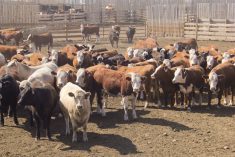Some hog producers in Canada may have to make the tough decision to shut down production because high feed prices could make operation costs too expensive, an industry official said.
Drought conditions damaged a lot of feed grain crops in the U.S. Midwest, which caused prices there to rally and the Canadian market has followed along.
"Because grain prices continue to be high, hog producers are starting to lose money now," said Brad Marceniuk, livestock economist and hog analyst with Saskatchewan’s ministry of agriculture in Saskatoon.
Read Also

U.S. livestock: Feeder cattle hit contract highs on tight supply
Chicago | Reuters – All Chicago Mercantile Exchange feeder cattle futures and most live cattle futures hit contract highs on…
"So, as they go into the fourth quarter they’ll have to make a decision to either borrow money to keep up or to close their operations down."
Marceniuk said hog prices are typically at their lowest point during the fourth quarter of the year (October to December). The price drop is usually caused by an influx of hogs heading into market and a drop off in demand as barbecue season comes to an end.
Hog producers aren’t alone in feeling the pressure from high feed prices in Western Canada. Cattle producers are also being hit fairly hard, Marceniuk said.
"It’s affecting feedlot producers because they are feeding barley and corn," he said. "But, cow-calf producers are not as affected because they’re feeding with pastures and hay right now."
Chris Panter, livestock market analyst with Alberta Agriculture and Rural Development in Edmonton, said there are a few steps livestock producers should take to address the problems being caused by high feed prices.
"One of the most important things to do now is know your costs and have an action plan to source feed," Panter said. "Talk to your neighbours about your feed supply needs and work together to address concerns. In most cases you want to search for the lowest-cost feed alternative."
Canadian producers probably won’t see relief from the effects of high feed prices anytime soon, Panter said.
"The extent of the drought in the U.S. and dry conditions in other grain-growing regions in Eastern Europe means we are likely to experience higher-than-normal feed grain prices for an extended period," said Panter.
A large corn crop in the U.S. would do a lot to reduce feed grain prices, but that likely won’t happen until next year at the earliest, Panter said.
— Terryn Shiells writes for Commodity News Service Canada, a Winnipeg company specializing in grain and commodity market reporting.















